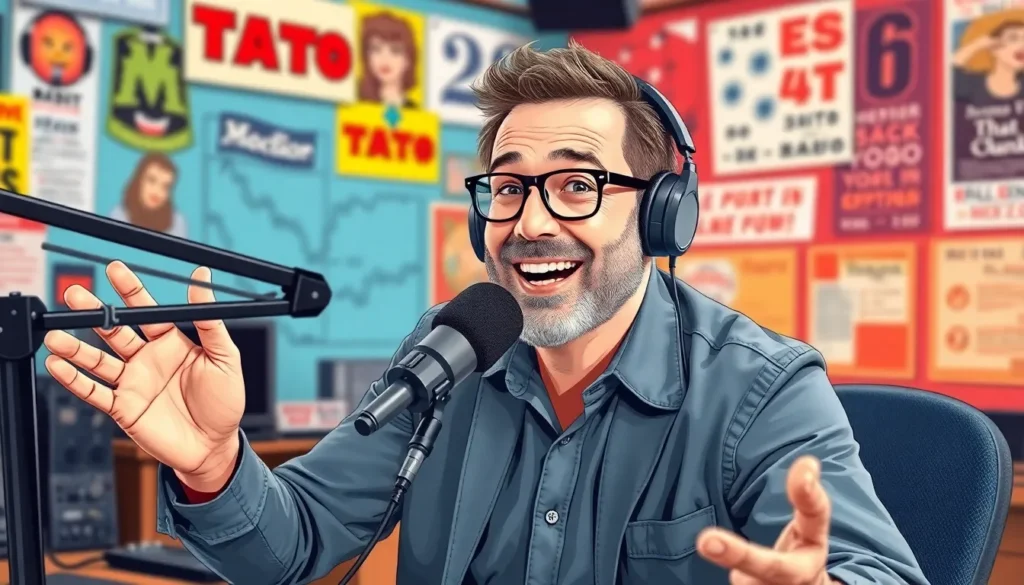Radio talk shows have been a staple of entertainment for decades, blending humor, information, and the occasional heated debate into a delightful auditory experience. Picture this: a charismatic host armed with a microphone, ready to tackle everything from the latest celebrity gossip to pressing political issues, all while keeping listeners chuckling in their cars. It’s like a front-row seat to a lively conversation that you didn’t even have to RSVP for.
In a world dominated by streaming services and social media, radio talk shows still manage to capture attention and spark conversations. They create a sense of community, bringing together diverse voices and opinions, all while reminding us that sometimes, laughter really is the best medicine. So, whether you’re a seasoned listener or a curious newcomer, it’s time to tune in and discover why these shows continue to resonate with audiences everywhere.
Radio Talk Shows
Radio talk shows serve as platforms for discussion, featuring a host who guides conversations and engages with guests or callers. These shows present a mix of entertainment, opinions, and information, covering a wide range of topics, including politics, health, and pop culture. Listeners often tune in for the lively debates and humorous exchanges that characterize many talk show formats.
Hosts play a crucial role in shaping the tone and direction of each episode. Their charisma often draws in audiences, maintaining listener interest throughout the broadcast. Guests, ranging from experts to celebrities, provide varied insights, enhancing the richness of discussions. Callers also contribute, adding an interactive element that fosters community engagement.
Broadcasting on AM, FM, or digital platforms, radio talk shows reach diverse demographics. This accessibility helps sustain their popularity, despite the competitive landscape presented by podcasts and streaming services. Real-time interaction with listeners often creates a sense of immediacy and relevance that pre-recorded formats lack.
Statistics indicate that radio remains a trusted source of news and entertainment for many. According to a recent survey, 75% of adults in the U.S. listen to radio at least once a week, underscoring the medium’s significance in daily life. Moreover, an engaging talk show can attract considerable audience numbers, showcasing the enduring value of radio as an information source.
With their blend of humor, information, and community interaction, radio talk shows continue to resonate. The format thrives on engagement, as hosts and guests spark conversations that keep audiences coming back for more. Whether through local stations or national broadcasts, these talk shows play a vital role in the radio landscape.
History of Radio Talk Shows


Radio talk shows have a rich history, evolving significantly since their inception. These platforms have entertained and informed audiences for nearly a century.
Early Beginnings
The origins of radio talk shows trace back to the 1920s. At that time, hosts began engaging listeners through casual conversations. Programs like “The Edward R. Murrow Show” emerged, focusing on current events and interviews. Pioneers in this genre laid the foundation for future shows, paving the way for a format that blends entertainment with information. The medium attracted a diverse audience, establishing radio as a household staple.
Evolution Over Time
As society changed, radio talk shows adapted. In the 1960s, hosts like Larry King and Jim Bohannon transformed the landscape with live call-ins. These interactions fostered a sense of community, allowing listeners to participate actively. The popularity of topical discussions surged during the 1980s, with shows tackling everything from politics to social issues. Today, digital advancements keep these programs relevant, enabling broader reach across platforms. This evolution illustrates radio talk shows’ resilience and enduring appeal, as they continue to engage audiences in meaningful dialogue.
Popular Radio Talk Show Formats
Radio talk shows adopt various formats to engage audiences effectively. Each format provides unique ways to convey information and entertain listeners.
Call-In Shows
Call-in shows invite listeners to participate actively. These programs encourage audience interaction by allowing real-time questions and comments from callers. Engaging with hosts, listeners can express opinions or seek advice on numerous topics. The spontaneous nature of call-in shows fosters dynamic conversations and surprises. Additionally, some hosts develop a rapport with frequent callers, enhancing community connection. This format proves particularly popular, as many audiences enjoy sharing their views live on air.
Interview-Based Shows
Interview-based shows focus on guest conversations, featuring personalities from diverse fields. These programs delve into insights and stories, allowing hosts to guide discussions on relevant subjects. Guests can range from celebrities to experts, bringing unique perspectives to the table. By asking probing questions, hosts draw out valuable information, creating compelling narratives. These shows promote education and awareness, as audiences acquire knowledge about specific issues or trends. Overall, interview-based formats captivate listeners with intriguing exchanges and informative content.
Impact of Radio Talk Shows
Radio talk shows significantly shape cultural norms and values, acting as catalysts for dialogue within society. They introduce listeners to diverse perspectives, elevating discussions about important issues. Guests from various fields enhance conversations, providing insights on everything from entertainment to social matters. Additionally, radio talk shows foster a sense of belonging, connecting listeners through shared experiences and conversations. Research reveals that 80% of listeners feel a personal connection to their favorite talk show hosts, reinforcing the community aspect of these programs.
Political discourse thrives within radio talk shows, offering a platform for lively discussions about current events. Hosts often challenge opinions and stimulate debate, influencing listeners’ viewpoints. These programs present various political ideologies, providing a space for marginalized voices to be heard. Statistics show that 61% of adults consider radio as a valuable source of political information. Engagement with political issues empowers listeners to become more informed citizens. As a result, radio talk shows play a crucial role in shaping public opinion and encouraging civic participation.
The Future of Radio Talk Shows
Radio talk shows continue to adapt in a digital world, maintaining their relevance across various platforms.
Digital Platforms
Digital platforms shape the future of radio talk shows significantly. Streaming services and social media allow hosts to reach broader audiences while engaging in real-time conversations. AM and FM signals complement online broadcasting, enriching listener experiences. A total of 75% of U.S. adults listen to radio weekly, reinforcing its established role in everyday life. Podcasting also ties into this evolution, with many talk shows offering episodes for on-demand listening. Additionally, platforms like YouTube enable visual engagement, attracting younger demographics eager for interactive content.
Audience Engagement
Audience engagement drives the success of modern radio talk shows. Call-in segments foster participation, allowing listeners to voice their opinions and shape discussions. Research shows that 80% of listeners feel connected to their favorite hosts, enhancing loyalty and community. Various social media channels facilitate instant feedback, giving shows an avenue for immediate interaction. Hosts often encourage listeners to contribute topics, creating a sense of ownership and inclusion. Furthermore, engaging with political issues attracts attention, with 61% of adults valuing radio as a political information source. These interactions cultivate informed citizens, reinforcing the vital role of radio talk shows in shaping societal discourse.



